You have a blog, you’re getting some traction. This article is for you!
Read this first is you’re still planning to start a blog.
We’ll go over 13 ways you can make money from blogging. Most of them are things you can do on your blog (I use WordPress as an example to setup monetization). Others are things you can do BECAUSE you write and people like what you’re doing.
Table of Contents
1. Ads are the easiest way to monetize your blog
By far the most easy way to make money with your blog is through Ads. It’s also the most intrusive method. Because you are taking something away from your visitors (the fact that they can read your articles in a clean non-distracting way).
I’ve chosen not to add ads to this blog. I want to make my money in other ways. About 100 websites of mine DO have ads. So I’m not saying you should write this idea off. I’m simply saying that this is a good way to make money but you should think about this one. Is the website, the audience suited to add ads? I have plenty of websites that only give information and people are quickly in and out. Because of the high volume of traffic but low engagement I add ads. On this blog I want it to be the other way. Less traffic but a more engaged audience.
If your website is going to be your livelihood I would definitely add ads to it at the start. You’ll immediately start making money. Even if it’s just a small amount.
Adsense
Adsense is by far the easiest way to monetize your blog. Go to Google.com/adsense and register an account. You’ll have to enter your first website url and add the code snippets to the website. It will take a few days before your website is reviewed after which ads will automatically start appearing. I’ll walk you through how to setup Google Adsense on your (WordPress) blog.
Don’t signup if you just started and still have the default “Hello Dolly” post up. Invest a few days in creating valuable content. Only then should you signup for Adsense and have your website approved.
Once your account is activated go to Ads -> Auto ads

Click on “Setup Auto Ads” on the right.

You’ll get a piece of code that looks like this:
<script async src="https://pagead2.googlesyndication.com/pagead/js/adsbygoogle.js"></script>
<script>
(adsbygoogle = window.adsbygoogle || []).push({
google_ad_client: "ca-pub-XXXXXXXXXXXXX",
enable_page_level_ads: true
});
</script>Include this code in your theme by going to Appearance -> Theme Editor and open the header.php file on the right side of your screen.
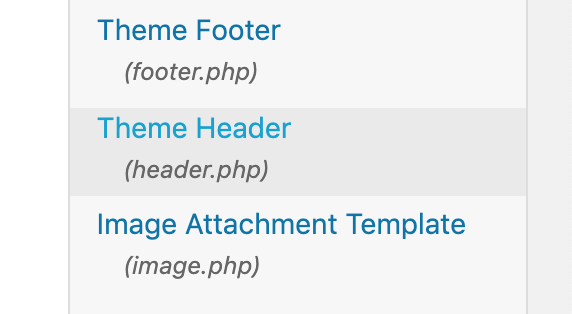
Click on your theme header and include the code between the <head> </head> element of the HTML
Just add a new line and paste it in there. Visit your website on a different browser and check your HTML code via Right click – view source to see if the code is in there.
Next up is the AMP code snippet (IF you downloaded and activated the AMP plugin). No ads will be shown on your AMP pages (so people visiting your website from a mobile phone) if you don’t also add the AMP Adsense snippet.
Click on the auto ads for amp tab.

Then go to step 2 and you’ll again get a code snippet.
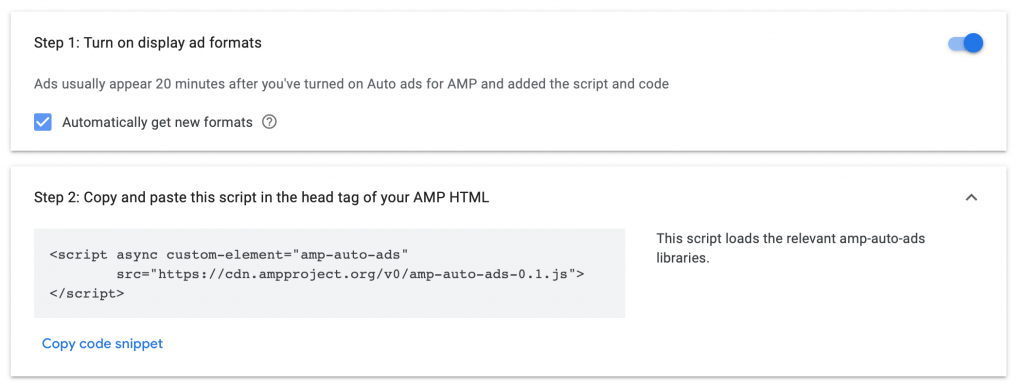
You can past this snippet immediately below the other snippet you just added.
<script async custom-element="amp-auto-ads"
src="https://cdn.ampproject.org/v0/amp-auto-ads-0.1.js">
</script>Go to step 3

Paste this code snippet in the same file but just after where you see the <body> tag.
<amp-auto-ads type="adsense"
data-ad-client="ca-pub-XXXXXXXXXXXXXX">
</amp-auto-ads>I removed my ID everywhere, so if you copy the above code(s) make sure you add your own ID to it otherwise you won’t get any ad impressions and subsequently no income.
It takes a few days for the ads to show.
In the meanwhile you have to do something else thats new for 2019. You have to add an ads.txt file to your web server with a line of text. Connect your domain to your Adsense account so Google knows your WordPress website hasn’t been hacked by someone else and they added their own Adsense code.

Download the ads.txt file and upload it to the route of your website. That’s usually the public_html folder.
Adsense is go great because you don’t have to do any work for the ads. Google acts as the middle men and has a large supply of advertisers. They also have advanced algorithms to try and get your RPM (Revenue per thousand impressions) as high as possible.
I do have some tips for you because Google is also the butcher that inspects its own meat. Google is a big advertiser on Adsense as well. They advertise Google Adwords on it and I’ve found that the RPM from these ads is very very low. So I excluded Google themselves from advertising on my websites. Hahaah 😂
This is how to do it. Click on Blocking Controls in the left menu
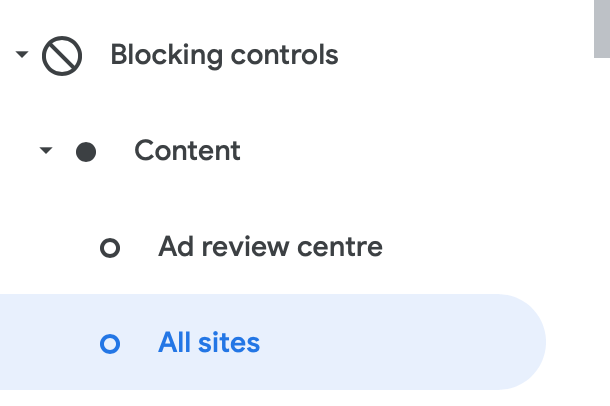
Look to the right and click on the 3 dots to open a menu. Click on “Return to the old Ad review centre”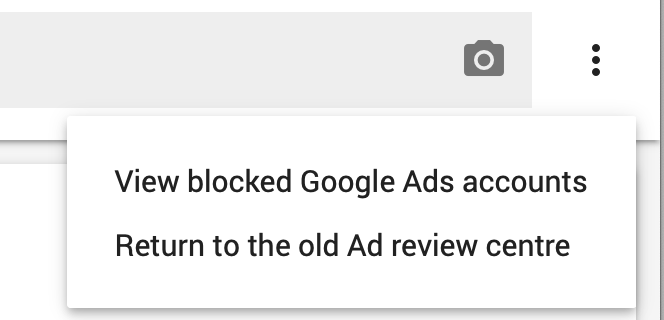
Next click on the “Advertiser URL’s” tab.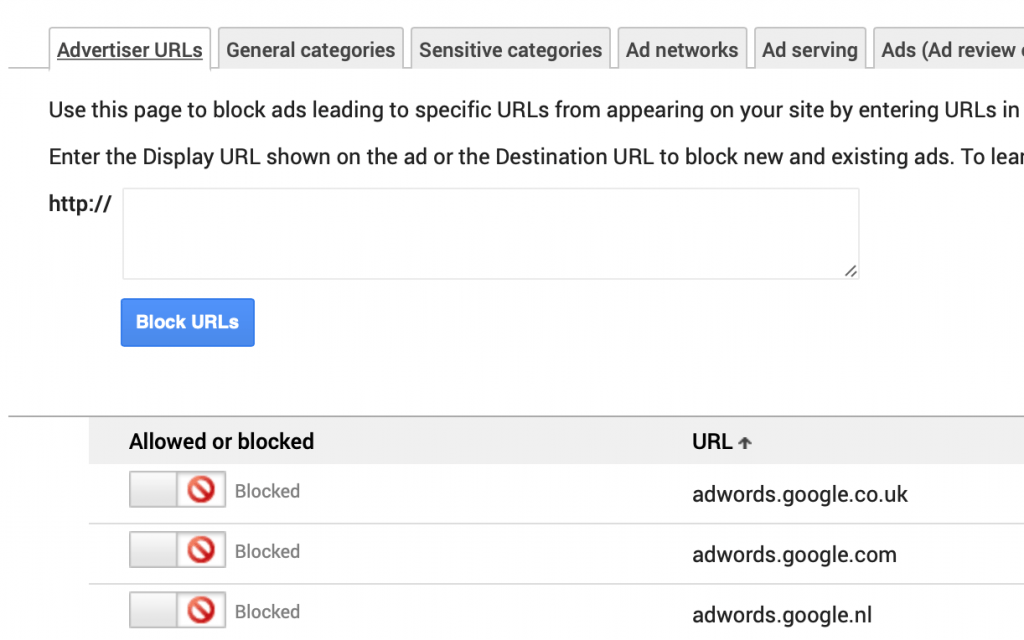
Add adwords.google.co.uk, adwords.google.com and any local equivalents (.nl etc.) to the blocking list. This will prevent the Adwords ads from popping up on your website.
How to optimize your Adsense earnings
The biggest part of your earnings from Adsense is through people clicking on your ads.
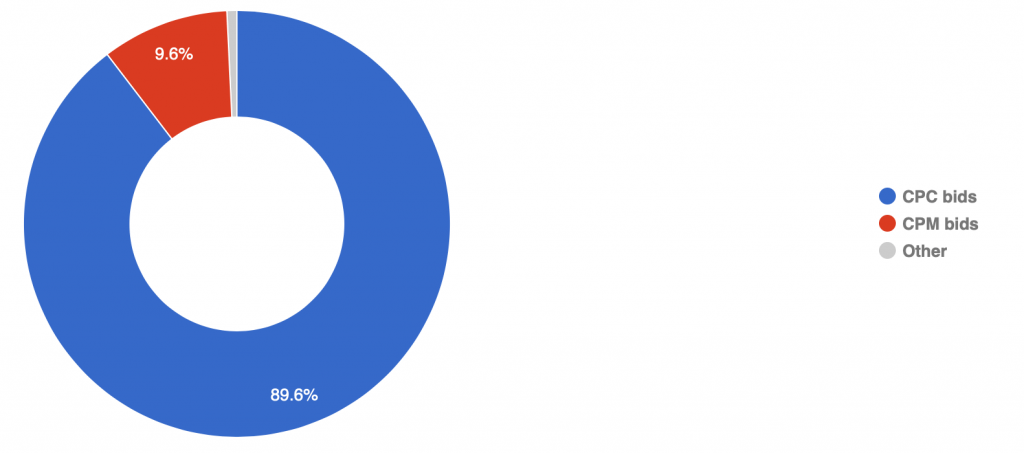
Mine is almost 90% from clicks (CPC bid, cost per click) and almost 10% is from views (CPM bids, or Cost Per Thousand views).
With Google’s new auto ads, they decide the best place to place your ads on your website. But a few years back you had to decide where you’d place your ad blocks. If you didn’t want to intrude your visitors you would put them below the fold. In the sidebar, etc.
If you still have the old ad blocks you should place them “in content” so people see your ads when they’re reading your content.
Optimize your ad impression share
Google is very adamant about the user’s experience. They don’t want to scare them off with a lot of ads. Rightfully so because before 2016 the use of ad blockers has soared to new highs.
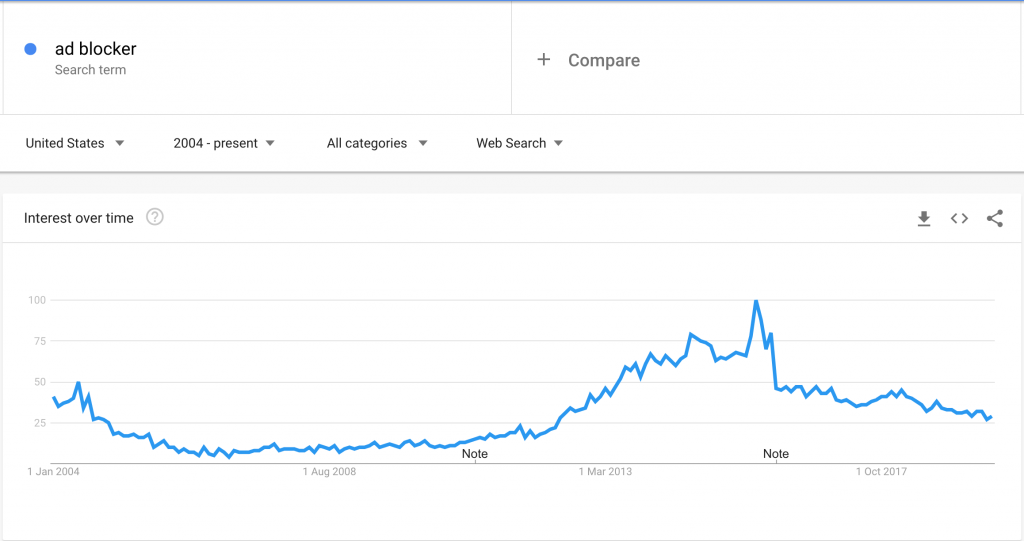
Users were just mad because websites were littered with ads. They loaded slow. Hid the content. User Experience from ads was just awful.
That all changed once the ad blocker became so popular. Google’s earnings were at risk and they needed to do something about it. A couple of years back they introduced a method to reduce the ad impressions you show your audience. Google also lists the amount of revenue you’ll lose when you ease back on the ads a little.
You should also optimize for impression vs ad revenue. This is how to do it. Click on optimisation -> experiment
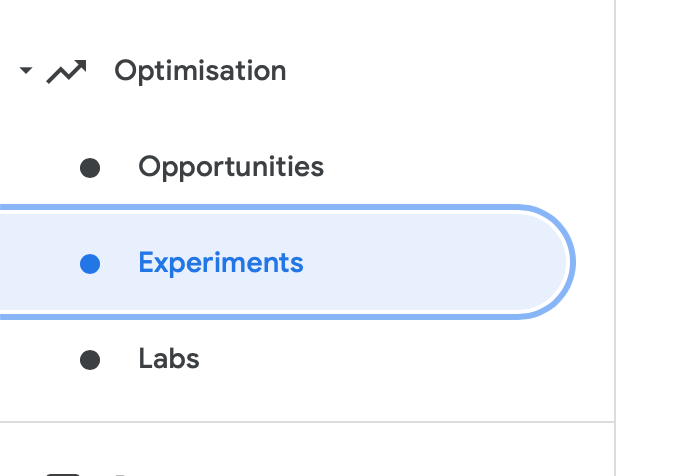
Next, click on ad balance experiment

I’ve experimented quite a lot with it. My sweet spot is 60% ad impression to keep 99% of revenue. If I go below 60% my revenue starts dropping (faster than Google is prognosing).
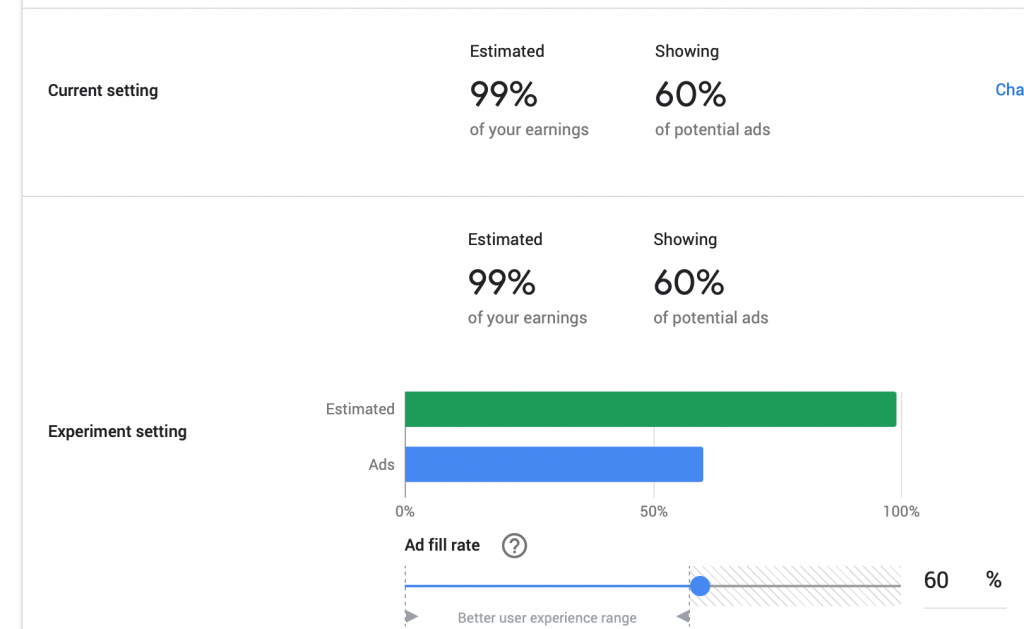
Setup your own experiment and see what happens. The reason I give up some ad revenue is because user experience and user engagement on your website is a known ranking factor. It’s a public secret that Google “sees” how long people stay on your website. The longer they stay the stronger the signal they give Google that your website should rank high(er).
Optimize your Adsense revenue even more with Ezoic (Advanced stuff…)
Ezoic is sort of an ad on to Adsense. They say (and I’ve seen it work) that they can optimize your ad revenue even more than Google can do. You should only apply when you make hundreds of Dollar each month. It’s quite a hassle really. It’s the only thing I don’t really like about Ezoic. Setting up the account is not really user friendly. I’ll try to walk you through it.

Register for an account on Ezoic.com.
Once you’ve registered follow the steps on the dashboard:
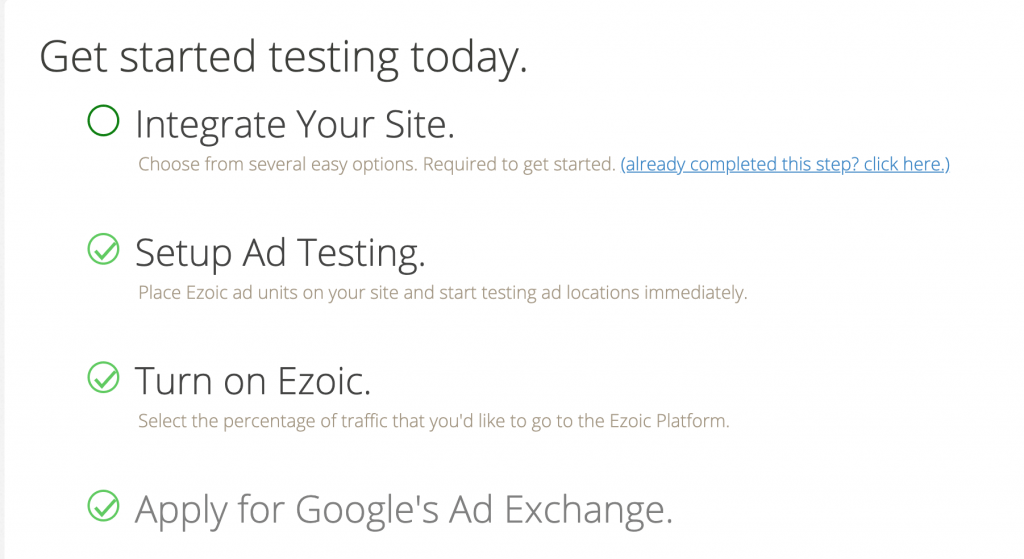
If you run your blog on WordPress install the Ezoic Plugin:
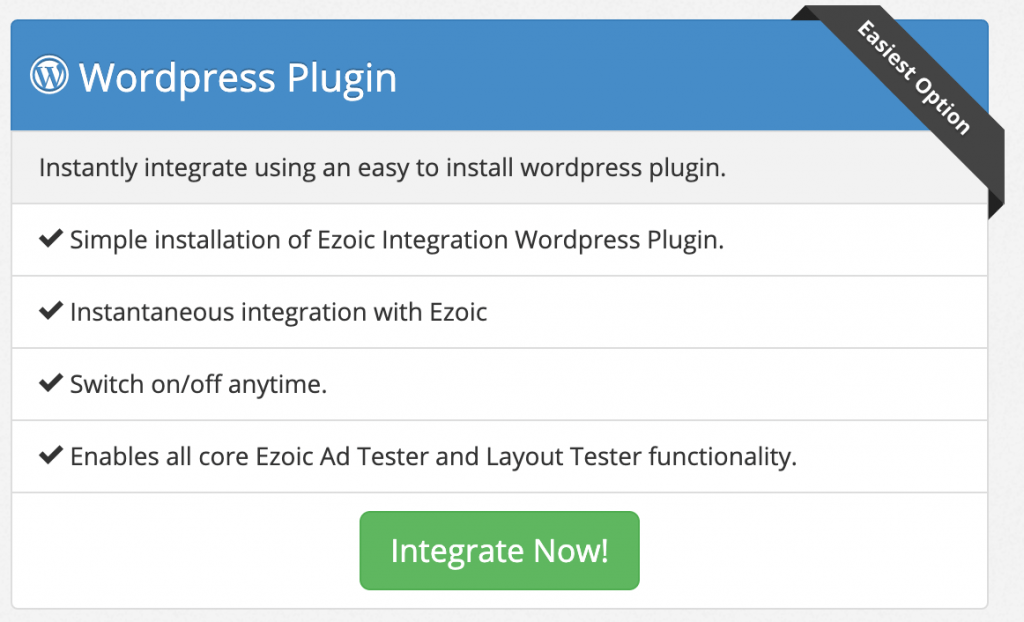
Once it’s downloaded activate the plugin and connect your account by logging in.

Continue to step 2. Setting up the ad testing.
If you installed the plugin, you don’t need to “wrap” your ads. Continue to the creation of the ads part.
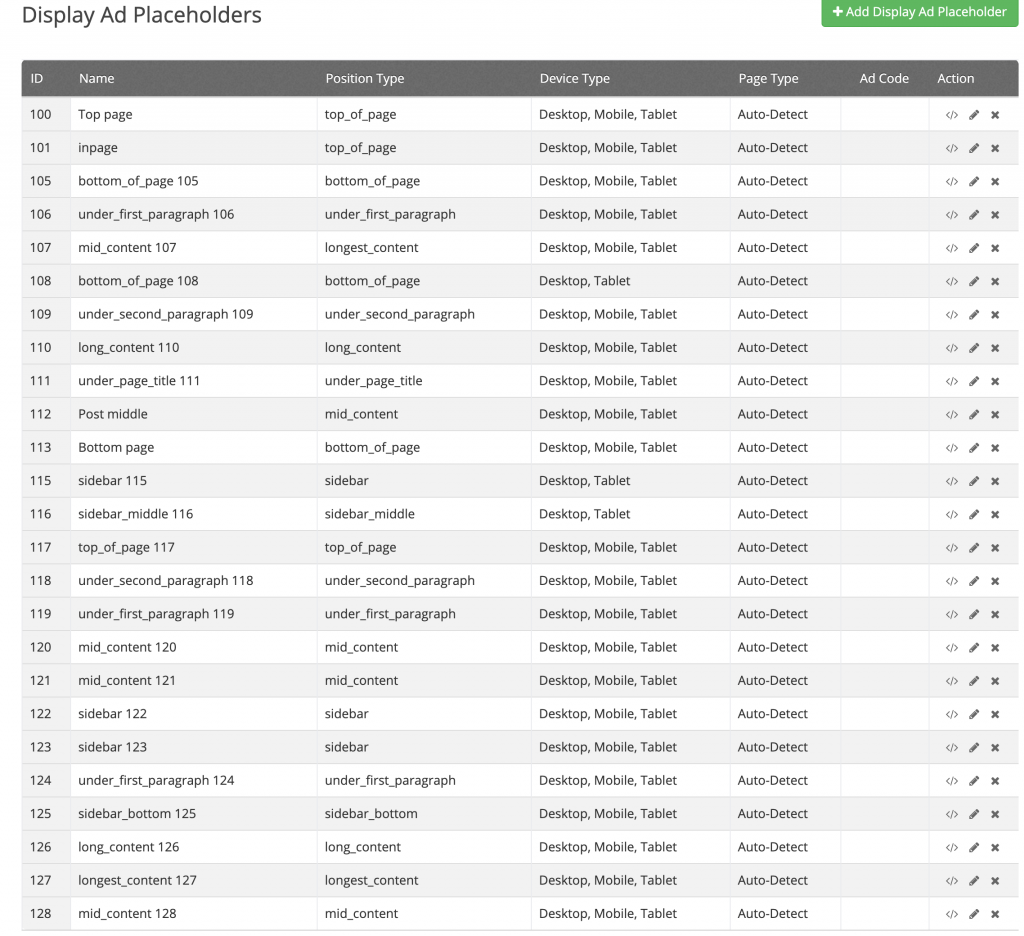
These are my ads lots for 1 website. Quite a lot. Click on the green button to start adding your own. This is a little bit technical but I’ll walk you through it.
Start by telling Ezoic where this ad placement will be shown. Remember, you need to manually ad code snippets to your pages later. You also need to add Adsense Ad Blocks before you can add Ezoic’s snippet code’s.
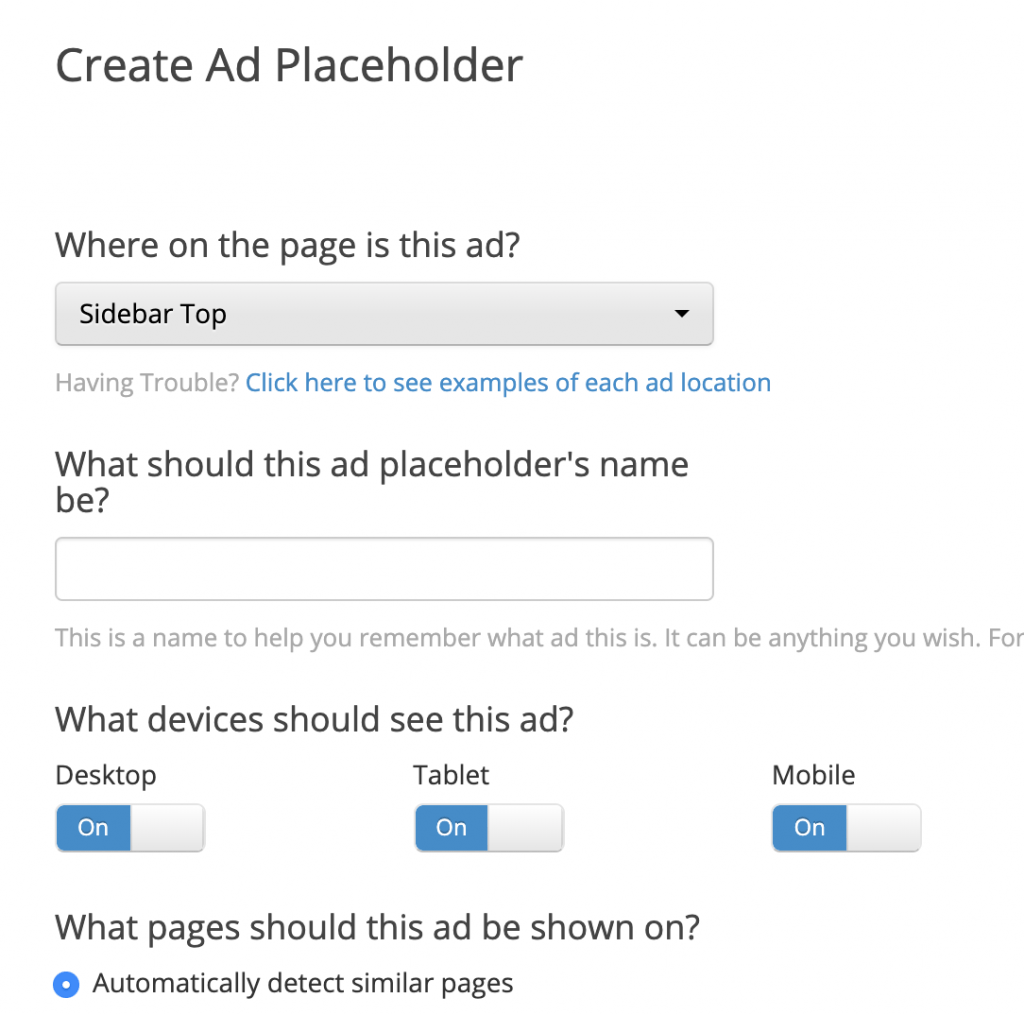
Next up is sizes of the ads and what type of devices you want the ads to be shown.
Top bar, in content and footers can show the widest version ads. The 728, 970 ads can usually be shown in those areas. If you’re not sure, just test it out. For every ad block, think about what size ads you want to show on what spots.
Select all the boxes you want. The more boxes you (can) select the better Ezoic can test and optimize your revenue for you.
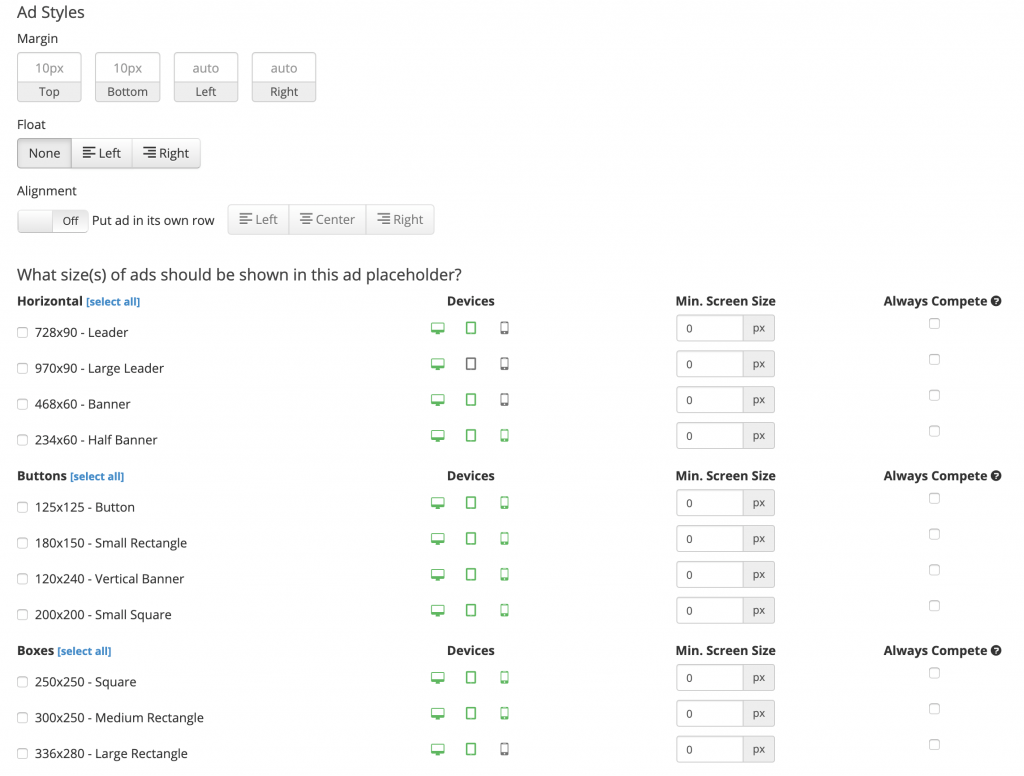
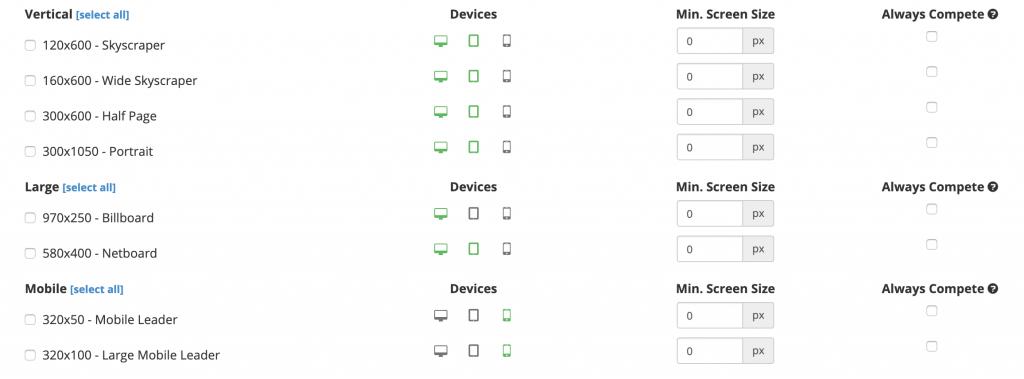
Don’t add a minimum screen size. Just uncheck the “devices” you don’t want to show your add to because the size just doesn’t fit the device.
For mobile you should uncheck:
- 120×600 skyscraper
- 160×1600 wide skyscraper
- 300×600 half page
- 300×1500 portait
- 970×250 billboard
- 580×400 netboard
Once you’re done selected / deselecting all your options click create ad.

Do this for at least 10 – 15 different ad blocks.
- Top navigation
- Top of the page
- Just below header of page
- Second paragraph
- Third paragraph
- Long form content
- Bottom of the page
- Sidebar big
- Sidebar small
- Footer
- Etc.
You’ll get a small code snippet for every block you create.
<!-- Ezoic - bottom_of_page 105 - bottom_of_page -->
<div id="ezoic-pub-ad-placeholder-105"></div>
<!-- End Ezoic - bottom_of_page 105 - bottom_of_page -->
How here’s where you have to deviate from Google’s Auto ads.
Go to Adsense again and click on ads -> ad unit -> responsive ad
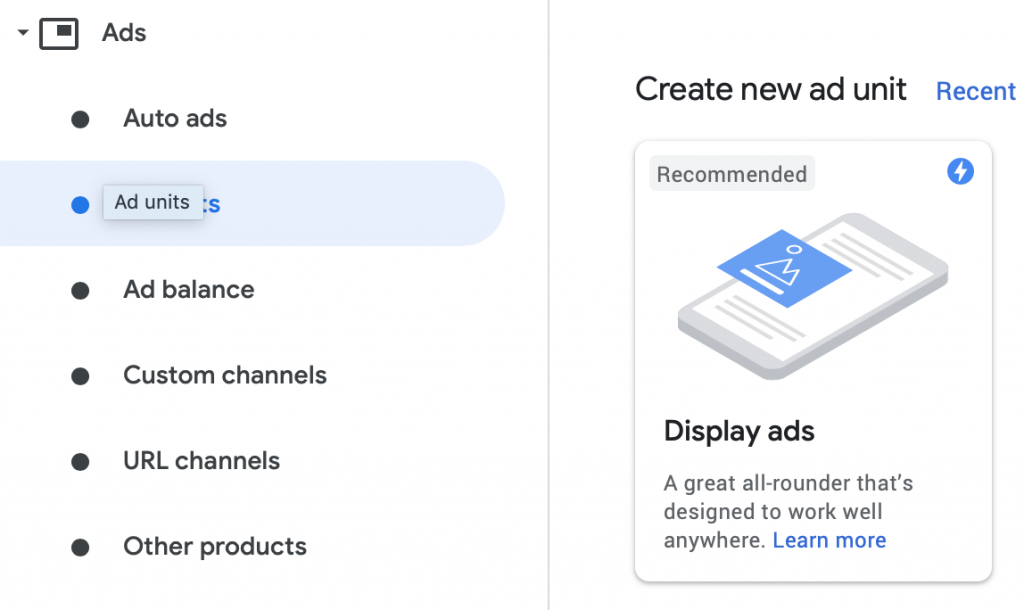
Add the ad. Give the ad block the same name as you did with the Ezoic ad so it’s easier to match them.

You need to combine Google’s Adsense snippet with the Ezoic snippet. This is Google’s one:
<script async src="https://pagead2.googlesyndication.com/pagead/js/adsbygoogle.js"></script>
<!-- bottom_of_page content -->
<ins class="adsbygoogle"
style="display:block"
data-ad-client="ca-pub-xxxxxxxxxxxxxx"
data-ad-slot="xxxxxxxx"
data-ad-format="auto"
data-full-width-responsive="true"></ins>
<script>
(adsbygoogle = window.adsbygoogle || []).push({});
</script>This is how the snippet should look like once you’re done
<!-- Ezoic - bottom_of_page 105 - bottom_of_page -->
<div id="ezoic-pub-ad-placeholder-105"><script async src="https://pagead2.googlesyndication.com/pagead/js/adsbygoogle.js"></script>
<!-- bottom_of_page content -->
<ins class="adsbygoogle"
style="display:block"
data-ad-client="ca-pub-xxxxxxxxxxxxxx"
data-ad-slot="xxxxxxxx"
data-ad-format="auto"
data-full-width-responsive="true"></ins>
<script>
(adsbygoogle = window.adsbygoogle || []).push({});
</script></div>
<!-- End Ezoic - bottom_of_page 105 - bottom_of_page -->Add this combination to your website. Download Advanced Ads Plugin for WordPress. Install and activate it. Add an ad by filling in the details here (just the title is enough)

Enter the combined code snippet below. Once you click Publish on the right side you can use the shortcode for this add and add it to one or more of your pages. This is a lot of work to setup yes… That’s why I told you to only do this when you have hundreds (if not thousands) of Dollar of ad revenue each month. You won’t get a lot out of it if you’re trying to optimize an ad revenue of 100 bucks a month.
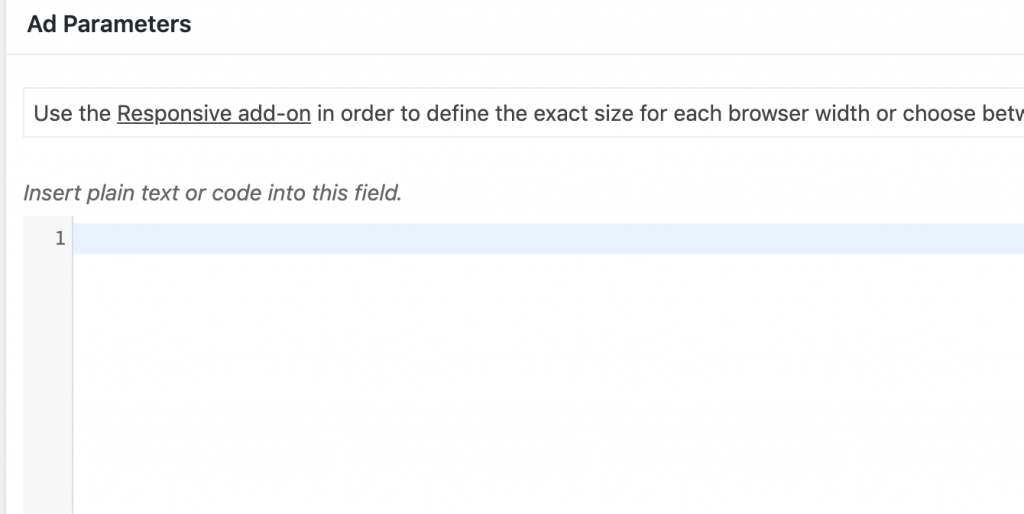
Use Media.net if you a 100k pageview a month website
Adsense is from Google. Media.net is from Microsoft. On Adsense anyone can join. On Media.net not so much so. You can only apply if you have a website that has 100k pageviews per month and you have a decent and up to date website.
I tried to apply the other day with one of my blogs I haven’t updated in months and I was not approved. Haha. Even though it gets more than 150k pageviews a month. So I need to update the content on it first.
You can always reapply but you should just get your stuff in order BEFORE you apply.
Actual people look at your website and determine wether you’re good enough for Media.net’s advertisers to join the programme. Once you do though… Your earning will skyrocket compared to Adsense.
2. Sponsorships
Once you get a bit of traction brands will start to approach you if you want to cooperate with them on a sponsorship deal. This usually only works though if you’re “out there”. If you audience (and the brands / advertisers) can see who you are.
You should have a clear author page that says a lot about you. Where you live, what you do. Advertisers want to be able to assess what risk they have of reputation damage. If you’re being sponsored by a vegan food brand and you have pictures online where you eat eggs or meat, that’s not really helping their brand is it?
If you want to accept sponsorships, if you want to be asked for sponsorship deals you have to be open about yourself.
Best is even to have your own Instagram account or Facebook page. That way the brands have an easier time assessing what impact you can make for their brand.
Listing your audience will also help you land sponsorship deals. How much traffic does your website get? What are the demographics of your audience? Any data that can help the brand to see if you align with their target audience should make it easier to land sponsorship deals.
Brand ambassadorships
One way to get your first sponsorship deals is to contact PR agency’s or the PR departments of brands you like. Brands are always on the lookout to reach new audiences.
Do make sure you have some traffic to show for. More and more brands are paying for actual sales in stead of just impressions or a post on someone’s website.
No pay no cure isn’t common but a base fee plus a feee based on number of interactions or sales is very common. Oftentimes brands want to see a minimum engagement level (on their site) before payment is made.
There are too many people (influencers) who have bought a massive amount of fake followers. Fake followers don’t buy anything. At most they might click through or like a post but that’s often not even the case. If you have social presence, make sure you only have genuine real followers. Brands don’t just look at follower counts anymore. They look at the ratio between interactions and followers and if that drops to a certain point they suspect you to have either have bought followers or you just don’t have an engaged following of people. Either one is bad.
Search Facebook for Ambassador Groups for example. There are also usually openings on job boards. Most of the Ambassador programmes either want you do directly promote their brand on a festival or something. Others are fine with you promoting them on your blog. Most earnings are made through sales. If you have a small following your earnings also will be low.
Press trips
If you own a lifestyle blog press trips should be your number 1 money maker. A new car. A new travel destination. New restaurant. There are so many opportunities out there IF you have the right blog.
Before you can land press trips you have to go through a few steps
- Grow a following (on Instagram or Facebook)
- Make it very clear to people what your “niche” is so brands can relate to you
- Align yourself with the brands you want to work with (writing style, target audience, other demographics)
- Become visible (start interacting with brands, join the right groups, accept speaking gigs (for free) where the same brands are present)
Do a search for “Influencer marketing platform” on Google and you’ll get quite a few results where you can sign yourself up to.
Here are my favourite blogger / influencer marketing platforms:
- Upfluence: You need to download Chrome plugin so Upfluence can “scrape” your social profiles and look at how much engagement your accounts have. They are a really big platform for influencers
- AspireIQ: is also a really big one. Easy to use platform. Payments are fast and they don’t take a cut from your pay check
Free products
Free products are probably the easiest to land as a sponsorship deal. Local companies are easiest to persuade to give you a product in exchange for a review on your blog. For a beginning blogger this is an excellent way to start your blogging career. Even if you don’t have a big following, you can do these reviews.
If you’re a bit cheeky you could ask for 2 products. 1 in exchange for the review on your blog the other one to give away to your audience. Tell the company that blogs that consist of giveaways tend to get more engagement. For one: that’s true. The second reason is giving away something to your audience is always a great thing. You can shout it out on Facebook or Twitter or Facebook. Do a Like & Share. Stuff like that.
3. Your own content upgrades
The highest margins are always made when you sell your own products. It’s also, in my opinion, easier to do. Your audience knows you. They came to your blog. Not someone else’s blog. They come to you for a reason. Maybe it’s just because you were the result they clicked on on Google. But if you’ve been blogging for a while you should have already gotten your own following.
Ebooks
The easiest way to make money with your blog and your own content is with ebooks. A comprehensive guide with case studies is a great way to start your ebook business. Just make sure it looks good and brings at least 100x the value you charge people. So if you charge $1 you should provide a minimum of $100 value.
Ebooks are generally priced till $10. Start with 1. See how it sells. You can always go up. Find someone on Fiverr or Upwork to make the ebook look nice if you can’t do it yourself. It should not be as blank as your blog.
An ebook should be seen more as a Powerpoint presentation which is converted to a book vs your blog.
Courses
Courses are about 10x harder to make but also at least 10x as valuable for you and you audience. I use Learnpress for my courses. It’s a plugin for WordPress and works great to setup your own courses.

Once you’re done setting up Learnpress you can install a sample course to see how it works. You can make really extensive courses with the free version. If you want extended options for payments and course types.
Products sales
If you have a a loyal following they’ll even by t-shirts with your name on it. But you should extend your product line with products that match your niche and the subjects you talk about on your blog.
Adding an online store to WordPress is easy at least. Woocommerce is free and comes out of the box. You can sell both virtual as physical products in your own online store.
From bingo cards to templates, to your ebooks we talked about earlier. Adding a store to your blog is easy and a great way to add as a revenue stream.
4. Affiliate marketing
Probably the number one thing starting bloggers make money with is with affiliate marketing.
Amazon is making more money from other people selling on their platform than they are making themselves with their own products. It’s the most basic form of affiliate marketing. They actually just refer traffic to themselves but by doing it there profit margin goes through the roof because of the network effect. The more products Amazon has the more likely people are to buy stuff there and the more likely they are to buy more products in the same order. The common road to affiliate marketing is referring traffic to someone else and earning a commission for every sale or lead from the visitor you sent.
If you have a blog you can sell your own product. A course, an ebook, another digital download, or even real life things you can ship via mail. Before you can sell something you made, you have to create it, install a service through which you’ll sell it (e-commerce storefront), start customer support, add a payment provider, etc. etc.
With affiliate marketing you have non of that. You simply add a link to your website which has your unique referrer code attached to it and when someone buys something via your link you get a commission.
You don’t have to do any support, no payment processing, nothing. The downside is, is that you’re not building your own customer base and you have to keep getting more clients who want the same thing over and over again. So in order for affiliate marketing to be interesting for you, you need quite a big audience and a lot of different advertisers.
How do I start with affiliate marketing?
Register an account at your local affiliate marketing network. If you Google it (in your local language) you’ll get the top networks. For the US, Canada and probably the UK your best bet is CJ.com. Commission Junction is the biggest of them all. The benefit of using the biggest? You only have to signup once to a platform and you’re able to apply your website to all the different advertisers they have on their platform.
If you have a lifestyle blog or blog a lot about products like electronics for example, signup for Amazon Associates program. It’s Amazon’s affiliate program.
They don’t pay a high percentage affiliate fee but their conversion rate is off the chart. Traffic you refer to their websites probably has the highest conversion rate of all your affiliate programs.
5. Youtube
YouTube is the world 2nd largest Search Engine after its bigger brother Google. The opportunities on YouTube are vast. You can make a lot of money if you’re active and active on regular times.
When you start on YouTube you should always post a new video on the same day and time of the week. YouTube rewards creators with more eyeballs who upload their videos on a regular interval. If you do it every Saturday morning at 10AM and do that on a weekly basis you’ll get more eyeballs (as in double, triple even quadruple the amount) compared to when you don’t upload new videos on regular intervals.
You can signup to YouTube’s Partner Program when you’ve reached 1k subscribers with a total time viewed of all your videos of 4,000 hours. YouTube does this so they can assess better what kind of content you make. What people watch your channel and how they comment. They try to filter out people who promote hate speech, terrorism, profanity, etc.
You need an existing Adsense account or you need to create a new one. Connect your YouTube Channel with your Adsense account.
6. Specials for food bloggers
Are you a food blogger? Or are you interested in becoming one and monetizing your website and video’s? If you haven’t started your food blog yet, read about starting a blog here.
You need a nice SEO friendly plugin to create your recipes with. Use WP Recipe Maker.
There are a lot of people who want to start a food blog. So help them with starting too! Start a course and show them how you got 1k, 10k, 100k visitors.
Make a course on how to create beautiful food photos. Probably the most important part of being a food blogger is creating great looking shots of the meals you made. Beautiful pictures get shared more and add to your standing as a professional blogger.
7. Specials for travel bloggers
Travel bloggers have vastly more affiliate options than your ordinary blogger. Signup for Booking.com’s Partner program. AirBnB has a partner program. Hostelworld has a partner program.
Traveladsnetwork is an affiliate network that specializes in the travel niche. If you signup with them you’ll get a wide range of possibilities to monetize your website with them.
Last but not least… Focus on travel insurance. World Nomands is one of those websites that offer travel insurance for travellers for decent rates.
There are also a lot of money making ideas you can try out BECAUSE you (have a) blog. You won't make money directly with your blog, but you can make money through blogging indirectly because you're improving on your writing and business skills.
8. Consulting
There are always people who need help with setting up their own website or blog and are very happy to pay for it.
Mapping out the road for them in your articles on your blog isn’t enough for them. They want tailor made advice. They might even want you to do part of the work.
When you consider consulting jobs make sure it’s worth your while. You’re building someone else’s asset. I’ve got websites where I spent less than 4 hours on and that made me over 10k in revenue. That’s 2,500 Dollar per hour and they still make money for me every day.
Consider what else you could be doing that can create revenue for you. Of course not everything should be measured in Dollar amounts. If you genuinely enjoy the consulting (I Know I do) you should defenitely consider doing it.
9. Ghost writing
Probably the best kept secret of Fortune 500 companies. Not everything that appears to have been written by their CXO is actually from their hand. They use Ghost Writers. Someone who writes an article, an opinionated piece and get paid handsomely. The CEO’s of big companies don’t have time (nor the writing skill) to publicize often. But they do want to use their influence and name to their advantage.
Ghost writers get paid handsomely for work where their name never gets mentioned. You’ll get a hefty NDA and a huge penalty if you even mention the fact that you did ghost writing for someone in company X. It’s a major reputation damaging fact if someone finds out there’s actually someone else behind the writing of a big shot in a company.
The compensation you receive usually amounts in the mid 4 figures to upper 4 figures range.
10. A Paid column
Unlike ghost writing with a paid column the client wants your name under the piece you’ve written. That’s also the value they’re paying for.
If you have a controversial opinion or a new vision on an (old) subject and you are known in the industry you will get asked to write columns for newspapers, magazines and online publications.
You can speed up the process of being asked by making sure you’re seen by the (chief) editors. Follow them on Twitter. Comment on their social feeds and their news items if you can. Add value to their work and you’ll be considered faster.
11. Medium
Medium.com is a website where normal people can write stories. They are awarded “claps” by the Medium community. Writers are paid based on the amount of claps they receive.
At the moment of writing this article (August 19 2019) Medium allows writers from 34 countries around the globe to join their partner program.
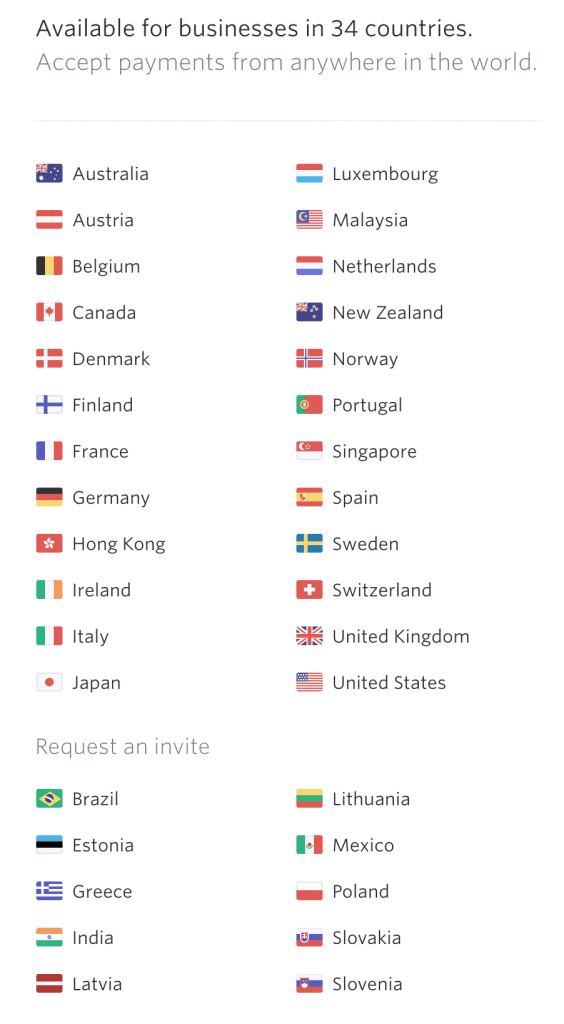
Medium has a tax wizard to guide you to which tax form to fill out. They explicitly mention that they do not give tax advice and neither do I… So consult a (local) accountant to help you find the right tax form to fill out.
There are a lot of writers on Medium that earn quite a bit of money with it. But you need to be a good writer and you need to enjoy writing. Don’t start writing on Medium because you want to make money. Start to write on Medium because you love to write.
Use Medium in combination with your blog
You can combine your writing on Medium with your articles on your blog. Try to write a prequel to a blog post you already made. That way you can link out to your blog in your Medium article. This is a great way to kill two birds with one stone.
You can also use Medium to drive email signups to your email list. Or, while it’s not prohibited to use affiliate links on Medium posts, you could get in trouble, you’re more free to use affiliate links on your own article you link to from Medium.
12. Coaching
Just like consulting you can coach other bloggers to create a successful blog like yours. Being successful is more than just having a great idea. It’s a mind shift. A habit.
You write something every week or every other day or daily. You think about your blog / your business on a daily basis. You’re always on the lookout for new angles for your blog. New additions to old articles.
This lifestyle, this habit is something you can teach other people too. Just like Steven Covey’s 7 Habits of Effective people. You could create your own: The XX habits of highly successful bloggers.
You might not be great at writing. Maybe you’re great at photography or Photoshop or Video. If you have your own blog you will become a master at something. And a master needs a student.
13. Speaking gigs
This isn’t for everyone. Most bloggers enjoy writing and doing some AMA’s or a bit of YouTube. But being in front of a real life audience is quite something else.
People want to learn and hear from a successful blogger. So expect to be invited to share your story on your niche related conferences.
If you haven’t been asked yet but would love to do a speaking gig… Just contact your favourite conferences and ask to speak. You probably won’t be able to charge something as opposed to being asked. But you can build a portfolio of speaking gigs and one gig leads to the next which leads to a paying gig.
14. Guest posts
A high authority blog also attracts advertisers that want to be seen by your audience. Who wouldn’t want to be featured on the WSJ or The Guardian. Well those articles aren’t for sale but your could sell your store space.
I have a blog that lands me a couple of hundred Dollar per month in guest posts. A lot of brands want “nofollow” links inserted in these guest posts. It’s a form of paid linkbuilding which is prohibited by Google. Or at least… Google wants you to “label” these links with nofollow tags so Google can see the difference between a paid link (which they don’t want to give any value) and a editorial link (which Google desperately wants to give value to and distinguish from the paid links).
15. Sell your website(s)
Once you build a following and you have traction you can start thinking about selling your website. Flippa is a website that is a marketplace for people who want to sell and buy websites.
You can normally ask 1x – 4x your yearly profit. So if you’re done with your blog or don’t think you can get it to the next level anymore you could consider selling it.
Do keep in mind that the moment you sell it is also the moment you lose an asset that could potentially land you a multiple in income over the next few years. Not just 1x to 4x but 10x if you keep building your blog.
I would only suggest selling your website if you’re really tired from doing the work and you’re ALSO seeing your traffic slide. If you do see your traffic decline, spend a couple of weeks / months to get it up again because you’ll get a much better price for a blog that’s on the rise than a blog that’s on a decline.